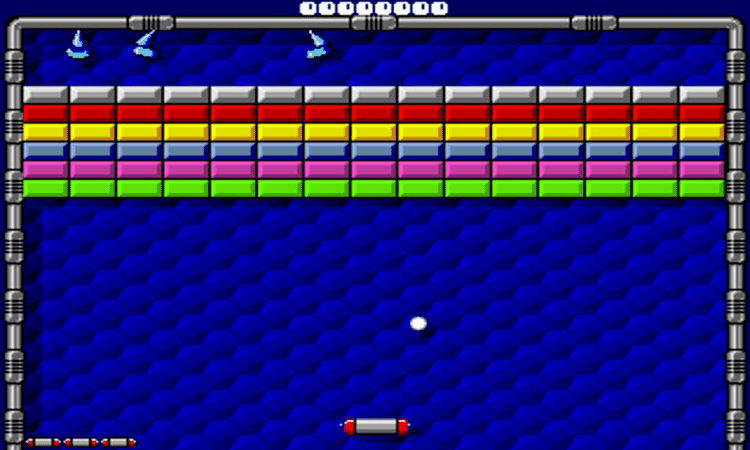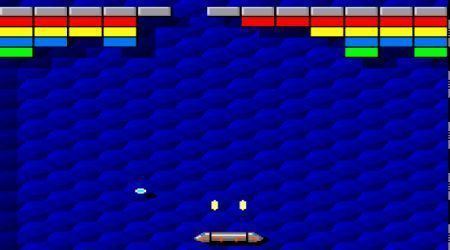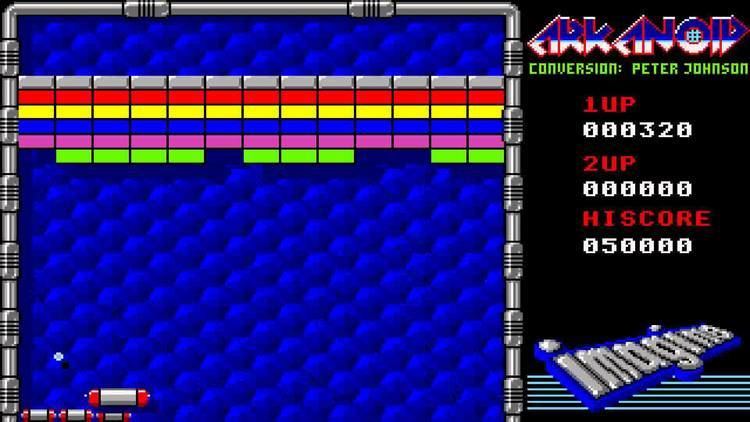Designer(s) Akira Fujita Release date(s) 1986 | Cabinet Upright Initial release date 1986 | |
 | ||
Awards Least Accurate CRASH Review Similar Taito games, Breakout clones, Other games | ||
Arcade longplay 270 arkanoid
Arkanoid (アルカノイド, Arukanoido) is an arcade game developed by Taito in 1986. It expanded upon Atari's Breakout games of the 1970s by adding power-ups, different types of bricks, a variety of level layouts, and visual layering and depth. The title refers to a doomed "mothership" from which the player's ship, the Vaus, escapes. Arkanoid revived the Breakout concept, resulting in many clones and similar games for home computers, even over a decade later.
Contents
- Arcade longplay 270 arkanoid
- 626 taito romstar arkanoid arcade video game like breakout tnt amusements
- Overview
- Reception
- Other media
- Ports and related releases
- References

626 taito romstar arkanoid arcade video game like breakout tnt amusements
Overview

The player controls the "Vaus", a space vessel that acts as the game's "paddle" which prevents a ball from falling from the playing field, attempting to bounce it against a number of bricks. The ball striking a brick causes the brick to disappear. When all the bricks are gone, the player goes to the next level, where another pattern of bricks appears. There are a number of variations (bricks that have to be hit multiple times, flying enemy ships, etc.) and power-up capsules to enhance the Vaus (expand the Vaus, multiply the number of balls, equip a laser cannon, break directly to the next level, etc.), but the gameplay remains the same.

At round 33 (36 for the NES version), the final stage, the player will take on the game's boss, "DOH", a head resembling moai. Once a player reaches round 33, he must defeat DOH with his remaining extra lives because there are no continues on the final round. In the NES version the final boss is on stage 36, and there are no continues throughout the entire game, so the entire game must be beaten in one sitting.
Reception

Upon release, the arcade game was critically acclaimed. In Japan, the Gamest Awards gave it the Silver Award for being one of the four best games of 1986, along with Taito's own Bubble Bobble, Sega's Fantasy Zone and Tecmo's Rygar. In Europe, it was reviewed by Clare Edgeley in the December 1986 issue of Computer and Video Games, where she compared it to Pong and Space Invaders in its simplicity and addictiveness. She described Arkanoid as "a lovely game" that is "Fast, colourful, simple and addictive" and concluded it to be a "great little game". It was also commercially successful in arcades. The game appeared at number-three on Euromax's nationwide UK arcade chart in 1987, below Capcom's 1942 at number-one and Westone's Wonder Boy at number-two.

The home versions were also well received. Computer Gaming World stated in 1988 that Arkanoid on the Amiga was "a perfect version of the arcade game ... incredible!" It named the NES version the Best Arcade Translation for the console that year, praising the graphics and play mechanics. The game was reviewed in 1989 in Dragon #144 by Hartley, Patricia, and Kirk Lesser in "The Role of Computers" column. The reviewers gave the game 5 out of 5 stars. Compute! named the game to its list of "nine great games for 1989", describing it as "hypnotic, addictive, and fascinating". Along with Breakout, the magazine noted Arkanoid also has elements of Pong and Space Invaders as well as Pac-Man in its use of power-ups.
A number of direct and indirect sequels were eventually developed for the market: Tournament Arkanoid and Revenge of Doh (Arkanoid II) both in 1987, Arkanoid: Doh It Again and Arkanoid Returns both in 1997, Arkanoid DS in 2007, Arkanoid Live and Arkanoid Plus! both in 2009 and Arkanoid Vs Space Invaders in 2015.
The controls used by various conversions differ from machine to machine, and some conversions allow for multiple control methods. The two basic control methods are digital and analog. Digital controls (many joysticks, control pads, etc.) are considered less desirable than analog controls (most mice, trackballs, and paddles); while digital controls limit the player to single-speed control, analog controls allow the player to move the Vaus at nearly any desired speed across the screen. The NES version of Arkanoid was originally packaged with what is considered one of the rarest of all NES controllers, the Vaus Controller: a small gray controller featuring one button, a small spinner (with limited turn angle), an adjustment port, and the Taito logo. While the game may be played with the standard digital NES control pad, optimum gameplay is achieved with the Vaus Controller. Latter-day MAME arcade cabinet developers have created customized spinner controls to further simulate the arcade experience, although the Arkanoid controller had quirks which have made it difficult to achieve 100% reproduction. The Japanese DS version features an optional paddle controller that connects in the Game Boy Advance slot, but the paddle controller is not being released in America.
Other media
Ports and related releases
Many of the 8-bit computer ports (ZX Spectrum, Amstrad CPC 464, Commodore 64, BBC Micro, MSX, Atari 8-bit, Apple II) were very popular in Europe in the 1980s. A console port on the NES was also popular, and the game was also ported for 16-bit computers Amiga, Atari ST, Apple IIGS and IBM PC. A Macintosh version was released in 1987 and a port was released for the TRS-80 Color Computer in 1989. A Super NES version called "Arkanoid: Doh It Again" was released in 1997. Arkanoid Returns and a sequel, Arkanoid Returns 2000, were released in Japan for the PlayStation. 16-bit versions had identical graphics as the arcade game. Commodore 64 conversion of Arkanoid is known as the first game for the system to feature music that used digitized samples (composed by Martin Galway). Computer conversions were published by Imagine. A version for the Nintendo DS handheld, titled Arkanoid DS, was released in Japan, with a North American release on August 1, 2008.
The Amiga version was reviewed in Computer Gaming World and praised as a perfect version of the arcade game. The review praised the computer versions for playability and features missing from other arcade-style games of the time, such as the ability to continue after all lives are lost.
An Xbox 360 version of Arkanoid, titled Arkanoid Live!, was released on May 6, 2009 on Xbox Live Arcade. A WiiWare version of Arkanoid, titled Arkanoid Plus!, was released in Japan on May 26, 2009, in PAL regions on August 21, 2009 and in North America on September 28, 2009. A version of Arkanoid for the iPhone was released worldwide on August 31, 2009 and appeared in the App Store on September 7, 2009.
In 2016 Facebook Messenger brought out a variety of games available to play in chat. One of these was Arkanoid.
